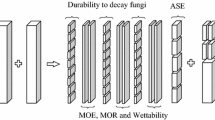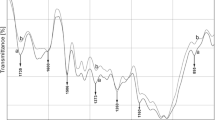Abstract
This report presents a new derivative from the chemical conversion of hardwood. Silylation of hardwood was successfully achieved using trimethylsilyl chloride with pyridine as base. The new wood compounds were analyzed by FTIR spectroscopy. The FTIR spectra of the silylated wood compounds show new absorption bands derived from trimethylsilyl ether groups. Furthermore, the products were investigated by means of EDX analysis. The presence of silicon confirmed the conversion of wood into the corresponding silyl ether derivative. Electron microscopy, i. e. SEM, shows that the location of the silicon was not restricted to the surface of the wood fibres. Penetration of the reactants into the wood body occurred, when a solid wood sample (beads) was used.
Similar content being viewed by others
Author information
Authors and Affiliations
Additional information
Received 5 April 1999
Rights and permissions
About this article
Cite this article
Zollfrank, C. Silylation of solid beech wood. Wood Science and Technology 35, 183–189 (2001). https://doi.org/10.1007/s002260000071
Issue Date:
DOI: https://doi.org/10.1007/s002260000071




